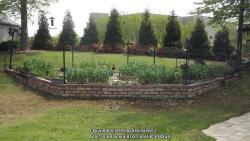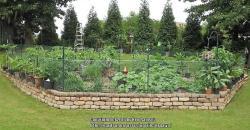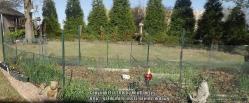johndriesse said:I lost 3 Azelas plants due to the clay soil never drained When we dug up the dead plants the hole were filled with water and now we dug up the entire bed about 3 feet long by 3 feet deep we are going to pu rocks in the bottom and sand and soil anything else we can put in to grow some plants live in South Carolina
Hi John! Welcome to NGA.
First, it's true that raised beds solve the heavy-clay-doesn't-drain problem. You could have standing water an inch deep over your whole yard, but if that raised bed stands 12-18 inches
above grade, you could WADE out to that raised bed and still grow fine crops!
But suppose you want to rescue some deeply amended beds that you just dug recently.
There are drainage solutions that go DOWN instead of UP, if you like digging trenches.
The problem is that water just doesn't perk fast enough through clay like ours to rely on drainage THROUGH the clay.
Once the hole fills with water, roots drown, just as you would if you buried your head under water or under mud, or even under water-saturated soil or clay.
When you dig a hole in heavy clay, it doesn't matter what soil amendments you put IN the hole, because that hole is going to fill with water. You could entirely replace the soil with anything you like: after the first rian, it will be waterlogged and stay that way for days or weeks.
The hole in the ground (anything BELOW GRADE) works like a bathtub: any water that enters, stays right there until it evaporates. You could fill your bathtub with pure Perlite and gravel, but it would still be
waterlogged and no air could get down to the roots.
Water excludes air, so the oxygen that the roots need to live has to TRY TO diffuse through waterlogged soil.
Well, oxygen CAN'T diffuse fast enough through water or water-logged soil to keep roots alive. Gasses diffuse literally 10,000 times faster through air than through water! For a root zone to NOT kill roots,
air has to enter the soil. Then more air can diffuse 10,000 times faster, and keep roots alive.
For air to enter the soil, water has to leave it. Good aeration is almost the same thing as good drainage.
Since water can't perk through heavy clay fast enough to keep up with even a light rain, water needs some other way out of that hole you dug.
Unfortunately, what with gravity, water only flows down. That's fine for draining the soil ABOVE, but when a hole is below grade, it would have to flow up to get out.
Instead, you have to give it an exit path that is entirely DOWN.
Whatever the low point in your planting hole or bed is, call that the "floor".
To drain the hole or bed, there has to be a trench (or pipe) that starts slightly BELOW the low point of your floor.
And that trench needs to slope uniformly DOWNWARDS if you want water to leave the bed and go somewhere else.
I just cut thin, shallow slit trenches as wide as the blade of my mattock (2-3 inches). I don't even backfill my slit trenches with gravel. The clay is so hard that they hold their shape like tiny concrete trenches.
Or you can dig a wider, deeper trench and bury perforated, corrugated plastic drainage pipe and backfill the rest with (heavy, expensive) gravel.
But you need a point that is
lower than the floor of your planting hole, to encourage the water to flow down TO.
If you don't have a slope or grade or low point to guide water towards, raised beds are the only drainage answer I know.
If you are lucky and the clay is only a thin layer that you can dig or drill THROUGH, you might drain a hole by digging down into a better-draining layer. But often clay layers can be hundreds of feet deep!
 03/2014
03/2014 07/2015
07/2015 03/2016
03/2016